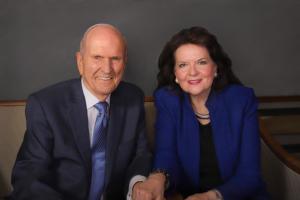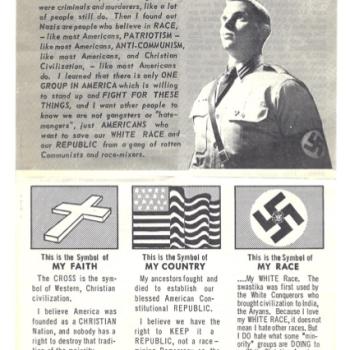Many journalists and scholars snickered a bit last year when President Russell M. Nelson announced that God no longer wanted the members of his church to call themselves Mormons. Instead, they were to use the really long full name: The Church of Jesus Christ of Latter-day Saints. They were to call themselves “members of The Church of Jesus Christ” or at least “Latter-day Saints.”

The snickering was in part because the church recently spent quite a bit of money on a public relations campaign titled, “I’m a Mormon.” Where they going to do another one, “I’m not a Mormon.” Also, what about the Mormon Tabernacle Choir? (It’s now the Tabernacle Choir at Temple Square). And ChurchofJesusChrist.org is replacing lds.org. Don’t worry, if you can’t remember the longer address, lds.org soon will get you to the new site.
Many people also snickered when the ninety-three-year-old Nelson succeeded his ninety-year-old predecessor Thomas S. Monson. Surely really old men do not make for vigorous leaders. In this case, Nelson does. As CNN’s Daniel Burke recently reported, Nelson leads by revelation, and he puts communications with the Lord more front and center than did many of his immediate predecessors:
When the messages come during the dark of night, Russell M. Nelson reaches for his lighted pen and takes dictation from the Lord.
“OK dear, it’s happening,” the president of the Church of Jesus Christ of Latter-day Saints tells his wife, Wendy Nelson.
“I just remain quiet and soon he’s sitting up at the side of the bed, writing,” she said in a recent church video.
The fact that Burke describes this as taking dictation suggests these are specific revelations — words from the Lord — rather than gentle proddings of the Spirit. The church’s leaders have not released any of Nelson’s revelations. That has not happened since 1918, when they shared Joseph F. Smith’s vision of Christ’s visit to the spirits of the dead after his crucifixion. Still, simply talking about receiving discrete, written revelations is a throwback to the leadership of nineteenth-century Mormon prophets.
Also, there have been a lot of changes in the last year. Shorter Sunday services. Fewer pageants. No more working with the Boy Scouts (who have also been changing a lot, though apparently not on the basis of revelation).
What about the “name change”? Why would Nelson embark on such a cumbersome project?
It’s worth paying close attention to the address Nelson delivered at the church’s semi-annual conference last October:
What’s in a name or, in this case, a nickname? When it comes to nicknames of the Church, such as the “LDS Church,” the “Mormon Church,” or the “Church of the Latter-day Saints,” the most important thing in those names is the absence of the Savior’s name. To remove the Lord’s name from the Lord’s Church is a major victory for Satan. When we discard the Savior’s name, we are subtly disregarding all that Jesus Christ did for us—even His Atonement.
From my vantage point, the setting aside of the term “Mormon” is best understood as part of what I call Mormonism’s christocentric turn. Please do not misunderstand my use of “turn.” The Church of Christ (as Joseph Smith and those who believed first called their church) was robustly christocentric from the get-go. I discuss this at length in my Mormon Latter-day Saint Jesus. Still, over the past several decades, the church has become even more robustly christocentric, both in its substance and in its messaging.
There are many examples. General conference discourses have abounded with references to Christ and the atonement in recent decades. (Gordon Shepherd and Gary Shepherd have demonstrated this quantitatively in their Kingdom Transformed). In meetinghouses, temples, and church publications, Christ-centered artwork has become even more prominent. In 1981, the church added “Another Testament of Jesus Christ” as a subtitle to the Book of Mormon. When the church redesigned its logo in 1995, it made the words “JESUS CHRIST” bigger.
There are internal and external explanations for these changes. In many respects, they represent the further flowering of theological ideas and trends from the early twentieth century. See, for instance, James Talmage’s Jesus the Christ (1915). Also, in the 1980s the church was responding to the Godmakers movie and endless criticisms from evangelicals, who crudely and rudely called the church an anti-Christian cult.
Nelson’s instructions on the church’s name very much fit within this larger pattern:
For much of the world, the Lord’s Church is presently disguised as the “Mormon Church.” But we as members of the Lord’s Church know who stands at its head: Jesus Christ Himself. Unfortunately, many who hear the term Mormon may think that we worship Mormon. Not so! We honor and respect that great ancient American prophet. But we are not Mormon’s disciples. We are the Lord’s disciples.
This is rather like Muslims objecting to older terms such as Mahometan or Mohammadans, and it’s also another way for The Church of Jesus Christ of Latter-day Saints to assert its Christian bona fides. Of course, for Nelson, and for Latter-day Saints more generally, theirs is the Church of Jesus Christ on the earth.
When the church announced its new guidelines on its name last year, I did not think it would persuade very many scholars and journalists to comply with its recommendations. The jury’s still out, I suppose, but it is very noteworthy that the Associated Press recently updated its Stylebook:
We are changing our style on The Church of Jesus Christ of Latter-day Saints. The church in 2018 began moving away from the widely recognized terms Mormon church and LDS church, and now prefers that its full name be used and that members be referred to as Latter-day Saints. (1/4)
— APStylebook (@APStylebook) March 8, 2019
In further tweets, the AP recommended that journalists “use the full name of the church on first references” and recommended phrasings such as “the church,” “church members,” and “members of the faith” on subsequent references. At the same time, the AP allowed that “for space or clarity” and especially in quotations, the term “Mormons” remains acceptable.
What should historians do? More on that in a future post.













